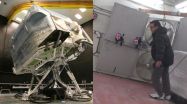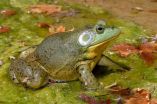(Press-News.org) WASHINGTON, D.C., March 17, 2015 - Winter storms dumped records amounts of snow on the East Coast and other regions of the country this February, leaving treacherous, icy sidewalks and roads in their wake. Now researchers from Canada are developing new methods to mass-produce a material that may help pedestrians get a better grip on slippery surfaces after such storms.
The material, which is made up of glass fibers embedded in a compliant rubber, could one day be used in the soles of slip-resistant winter boots. The researchers describe the manufacturing process in a paper in the journal Applied Physics Letters, from AIP Publishing.
The researchers are testing the material in an innovative, self-contained lab space that can be hoisted in the air and tilted to create sloped floors covered in ice and snow. The incline is increased until volunteers wearing shoes with soles made from the textured rubber start to slip. (The lab is also equipped with a padded wall and a safety harness to prevent any dangerous falls.)
"I think anyone who has slipped or fallen on ice can testify that it is a painful or nerve-raking experience," said Reza Rizvi, a postdoctoral fellow at the Toronto Rehabilitation Institute who works on developing materials that can provide better traction on ice. "Now imagine being frail or disabled - a slippery sidewalk or a driveway is all that it takes to trigger a life-changing fall. A serious fall on ice resulting in a hip fracture can be a death sentence for an older adult."
Tilak Dutta from the Toronto Rehabilitation Institute, a lead member of the research team, points out that actual falls are only part of the problem. "Equally important are the many older adults who feel trapped indoors for long stretches in the winter because of the fear of falling. The lack of activity and isolation have major negative impacts on health. We need to give older adults better footwear so they feel confident maintaining their outdoor activity levels in the winter."
Ice can be such a dangerous surface, Rizvi said, because when the temperature gets close to zero degrees Celsius, a thin, lubricating layer of liquid water easily forms on top of the ice. Cleated footwear provides effective winter traction because the cleats dig into the still solid ice beneath the slippery layer of water, Rizvi said, but cleats can be dangerous if the wearer does not take them off as they go inside. Cleats are very slippery on hard, wet marble or tile surfaces, for example, so a better solution for winter footwear is needed, the researchers said.
Turning Rubber into Sandpaper
Rizvi and his colleagues, including Hani Naguib from the Smart and Adaptive Polymers Lab at the University of Toronto, have developed a new method to manufacture a type of rubber that "digs in" on the micro-scale. The material is made up of thermoplastic polyurethane, a rubbery plastic, embedded with tens of thousands of tiny glass fibers that protrude out of the rubber like microscopic studs and give the material the feel of fine sandpaper.
The material looks like regular rubber and will stretch and deform in similar ways, said Rizvi. The material also performs just as well as regular rubber on dry surfaces such as quarry tile, he added. But on ice the rubber-glass fiber composite provides significantly better traction.
"The observed friction coefficients of the composites that we've developed would translate into fewer incidents of pedestrian slips," Rizvi said. "Implementing these in our daily lives would reduce winter related injuries."
Existing methods for fabricating the material require first extruding a rubber slab with glass fibers running parallel with the surface. The slab is then cut and reoriented so that the fibers stick out of the surface like the pins in a pincushion.
"The materials required for creating a high friction composite are not expensive, but the process of slicing and rearranging the rubber is not easily scalable," Rizvi said. The team has found a way to automate the process so that the material could be cheaply mass-produced.
The team noted that there is further work to be done to improve the wear-resistance of the material. Their testing has shown that the slip-resistant properties of the material fade with use so it would not be appropriate for commercial footwear until its robustness is improved.
"I am most excited about taking my research and having it applied to a serious societal issue of winter safety," Rizvi said.
"This work has the potential to have a real impact on the massive, expensive public health problem of winter falls, not to mention the dramatic improvement in quality of life for those living in northern climates," Dutta added.
INFORMATION:
The article, "High Friction on Ice Provided by Elastomeric Fiber Composites with Textured Surfaces," is authored by R. Rizvi, H. Naguib, G. Fernie and T. Dutta. It will be published in the journal Applied Physics Letters on March 17, 2015 (DOI: 10.1063/1.4913676). After that date, it can be accessed at: http://scitation.aip.org/content/aip/journal/apl/106/11/10.1063/1.4913676
The authors of this paper are affiliated with the Toronto Rehabilitation Institute and the University of Toronto.
ABOUT THE JOURNAL
Applied Physics Letters features concise, rapid reports on significant new findings in applied physics. The journal covers new experimental and theoretical research on applications of physics phenomena related to all branches of science, engineering, and modern technology. See: http://apl.aip.org
For every parent who ever wondered what the heck their teens were thinking when they posted risky information or pictures on social media, a team of Penn State researchers suggests that they were not really thinking at all, or at least were not thinking like most adults do.
In a study, the researchers report that the way teens learn how to manage privacy risk online is much different than how adults approach privacy management. While most adults think first and then ask questions, teens tend to take the risk and then seek help, said Haiyan Jia, post-doctoral scholar in ...
Large-scale climate patterns that affect the Pacific Ocean indicate that waters off the West Coast have shifted toward warmer, less productive conditions that may affect marine species from seabirds to salmon, according to the 2015 State of the California Current Report delivered to the Pacific Fishery Management Council.
The report by NOAA Fisheries' Northwest Fisheries Science Center and Southwest Fisheries Science Center assesses productivity in the California Current from Washington south to California. The report examines environmental, biological and socio-economic ...
AUSTIN, Texas - A new method of testing the most common cause of life-threatening infection in people with cystic fibrosis could improve efforts to study and combat the illness.
The bacterium Pseudomonas aeruginosa is a leading contributor to hospitalizations, serious illness and early death for people with cystic fibrosis (CF). Scientists at The University of Texas at Austin have found a way to re-create conditions specific to the environment in which the bacterium spreads in the lungs of a person with CF, allowing them to identify several genes that appear to be necessary ...
The New Zealand Meteorological Service issued a Storm Warning for the Chatham Islands today as NASA's RapidScat instrument found that winds in one quadrant of Ex-Tropical Cyclone Pam is still generating tropical-storm-force winds east of its center.
The International Space Station's RapidScat instrument captured data on Ex-Tropical Cyclone Pam's winds on March 16 from 08:30 to 11:36 UTC. RapidScat revealed sustained winds over 30 meters per second (108 kph/67 mph) were still occurring southeast of the center.
The forecast calls for southwesterly winds to 50 knots (57 ...
INDIANAPOLIS - An Indiana University cancer researcher and her colleagues have identified genetic markers that may help determine who benefits from regular use of aspirin and other nonsteroidal anti-inflammatory drugs for lowering one's risk of developing colorectal cancer.
Previous studies have shown that regular use of aspirin and NSAIDs lower one's risk of colorectal cancer, but their use is not recommended as a way to prevent the disease because of uncertainty about the risks and benefits. Thus, the researchers set out to examine the interrelationship between genetic ...
New research published with the support of the FP7 large-scale bioinformatics project Building the European Biodiversity Observation Network (EU BON) and the Alien Challenge COST action reveals the importance of open data in the study and control of invasive alien species. The study was published online in open access in the journal Management of Biological Invasions.
Invasive alien species cause a wide variety of problems, including issues related to conservation; to human and animal health; to agriculture and to fisheries management. But how can science be useful to ...
Cramping abdominal pains, diarrhea, bloody stools--these are common symptoms of chronic inflammatory bowel disease. Every year, up to 1470 children and adolescents in Germany develop the disease. But chronic inflammatory bowel disease is mostly diagnosed too late in these patients, as Stephan Buderus, Dietmar Scholz, and colleagues show in an original article in the current issue of Deutsches Ärzteblatt International (Dtsch Arztebl Int 2015; 112: 121-7). The average delay between initial symptoms and diagnosis is four to six months. In most cases, the inflammation ...
DETROIT - New animal studies at Henry Ford Hospital found that sildenafil, a drug commonly used to treat erectile dysfunction, may be effective in relieving painful and potentially life-threatening nerve damage in men with long-term diabetes.
The research targeted diabetic peripheral neuropathy, the most common complication of diabetes, affecting as many as 70 percent of patients.
The study was recently published online in PLOS ONE.
Lei Wang, M.D., the Henry Ford neuroscientist who led the research, said that although numerous drugs have been shown to be effective in ...
CLEVELAND, Ohio (March 17, 2015)--Hormones may not protect women from heart disease or stroke after menopause, but when combined with cholesterol-lowering statin drugs, they may help protect women from these killers, shows a population study from Sweden to be published in the April issue of Menopause, the journal of The North American Menopause Society (NAMS). During the study, women who took both hormones and statins had a significantly lower risk of dying of any cause and a moderately lower risk of dying of cardiovascular disease.
Using health information from national ...
CLEMSON, S.C. -- Placing less reliance on monitoring software and modifying new media training to align with student-athletes' habits and input will promote more positive and responsible usage of social networks.
This is the key finding by researchers from Clemson University, Baylor University and the University of Florida and published in the International Journal of Sport Communication.
The study explored college athletes' social media use and their experiences with and attitudes about a rising trend in college athletics: social media education.
Given the media ...




